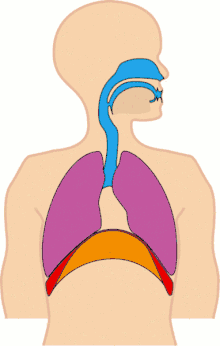Complete breathing
Complete breathing is a form of yogic breathing exercise. It is a form of diaphragmatic breathing and is the most basic of yogic breathing exercises.

Costal breathing
Costal breathing is the inhalation by lateral expansion of the ribs, using the external intercostal muscle to lift the costals to enlarge the thorax. Moreover, the shoulders are lifted when breathing, and the breath is inhaled shallowly, so it is also called shoulder breathing, clavicle breathing or high chest breathing. Only the upper part of the lung, the alveoli, is working. The alveoli in the middle and lower lobes, which comprise four-fifths of the lung, are resting. In this way, the middle and lower lung lobes can not exercise, and long-term waste quickly causes lung lobe ageing.
Clavicular breathing
Clavicular breathing is the final stage of the overall chest expansion. It happens after the chest inhalation is complete. To get more air into the lungs, the upper ribs and collarbones are pulled upward by the neck, larynx and sternum muscles. This requires maximum chest expansion during inhalation, and only the upper lobe of the lung is involved in air exchange. Clavicular breathing in daily life should only be used during extreme exhaustion or airway obstruction, such as asthma.[1]
See also
- Pranayama, the yogic practice of focusing on breath
References
- "锁骨式呼吸(Clavicular Breathing)" [Clavicular Breathing]. 喜马拉雅瑜伽传承_喜马瑜伽(西安)培训中心官网 (in Simplified Chinese). Retrieved 2023-06-09.